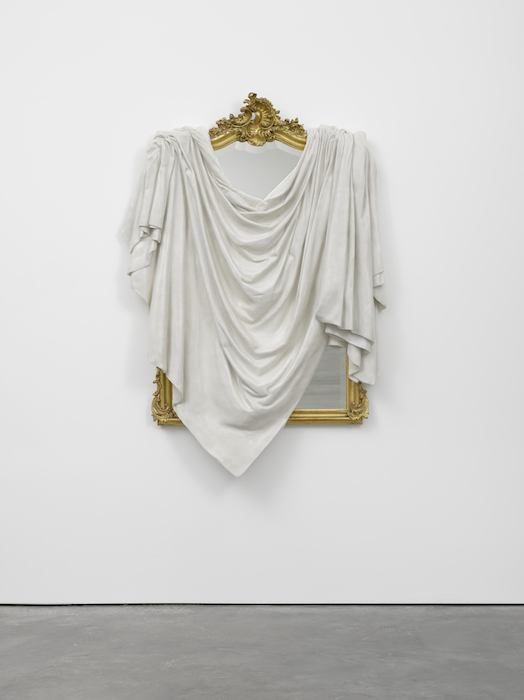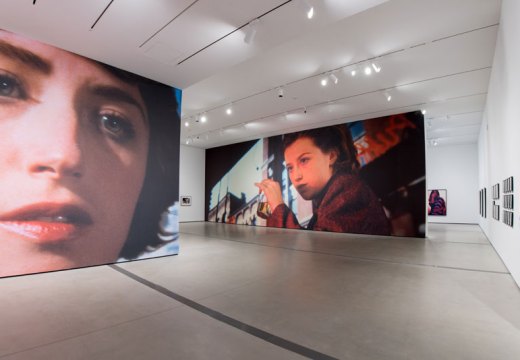Whenever I enter an art gallery, I typically expect to be the one doing most of the looking. Yet when I walk into Ryan Gander’s current solo exhibition at New York’s Lisson Gallery, I immediately become the object of someone’s – or, something’s – gaze: a pair of animatronic eyes, decked out with lids, lashes, pupils and brows, is affixed to the wall near the reception desk. Its pupils remain fixated on me as I slowly, suspiciously walk past. Utilising an economy of mechanical movements – the eyebrows, for instance, are mounted to three vertical tracks, allowing them to arch and frown, scowl and beg – these eyes display a vast range of expressions, from curiosity to pathetic remorse.

Dominae Illud Opus Populare, 2016, Ryan Gander. Courtesy Lisson Gallery; © Ryan Gander
When I speak to Gander about the piece, a few days before the opening of the exhibition, he explains to me that viewers are often ‘in a position of power’: ‘I quite like the idea that you go into an exhibition, and the exhibition would look at you, and make judgements about you. And you feel like you’re the spectacle, not the spectator.’
I venture that the show’s title, ‘I can see straight through you’, seems to reflect the first-person perspective of the gallery itself. Gander affirms that it’s not only the gallery, but really the whole ‘institution of art’ that is animated: ‘the maker, the architecture, the white wall, the history of art.’ As such, Gander’s work seems to objectify the viewer, upending the stability of our traditional relationship to art –our capacity to look, forge meaning, critique or historicise. While many contemporary artists, especially since the 1980s, have sought to reverse or return ‘the gaze’, Gander has literalised this idiom with Dominae Illud Opus Populare (2016), the ‘female’ counterpart to an earlier set of eyes called Magnus Opus (2013).

Fieldwork 2016 (detail), 2016, Ryan Gander. Courtesy of Lisson Gallery; © Ryan Gander
I turn a corner in the gallery to find a Le Corbusier chair, where I sit, as though watching television, to view a monumental installation entitled Fieldwork (2016). To install this piece, a massive conveyer belt has been constructed in the gallery and concealed behind white drywall. Through a single cutout window, I watch as 34 sculptures pass by: a collection of protective helmets, a taxonomy of mints on a velvet jewellery tray, a set of burner phones. The piece triggers a mild feeling of impatience, toying with our shrinking attention spans in the age of Snapchat and selfies. Gander somewhat cynically tells me that ‘Fieldwork is like an exhibition for lazy people. It’s like looking at art on your phone […], it scrolls past you.’
As with the animatronic eyes, Fieldwork disarms the seasoned viewer: ‘You usually go to an exhibition, and you navigate around the things and choose how long to spend with them, what deserves your attention, what intrigues you, what doesn’t intrigue you.’ Instead, we are forced to sit still while Fieldwork moves before us. In the event that you are intrigued by, say, a green Waitrose shopping bag with Aurebesh-language embroidery, or a suitcase filled with fake money, you have a mere ten seconds to study the object before it scrolls out of view.

Fieldwork 2016 (detail), 2016, Ryan Gander. Courtesy of Lisson Gallery; © Ryan Gander
There are no hierarchies or fixed meanings in Fieldwork. ‘I like the idea of having a collection and replacing things,’ Gander explains. ‘Taking some things out and putting some things in, and forging associations between [them].’ We joke about the scenario of alien archaeologists who must interpret human civilisation through its vernacular, material culture. When asked what these hypothetical aliens might think of Fieldwork, Gander guesses that they may regard it as ‘a time capsule’ or a kind of anthropological archive of human life. I play along, suggesting that the burner phones, for instance, could be a commentary on how people manage to circumvent rules and create underground systems of exchange. ‘The essay that I wrote about the burners [each object is accompanied by a descriptive essay] doesn’t contain any of that,’ he replies, but he seems intrigued by the display’s polysemic potential.
While the title, Fieldwork, recalls ethnographic research, it could also hint at the compression of three-dimensional objects into a flat image field, or a screen. Gander complains, later on, that while art could be anything from a McDonald’s uniform to a bottle of water, most of it is still shown on the wall. ‘Art is about exploration and learning and trying new things,’ he implores. In his multifaceted practice, Gander has continued to surprise, shock and intrigue audiences. Visitors to his 2011 Artangel exhibition ‘Locked Room Scenario’ assumed the role of detectives, exploring an enigmatic environment filled with actors and hidden clues; for Documenta13, in 2012, he ‘displayed’ an invisible but tangible ‘cool breeze’ inside the Fridericianum.

I be…(x), 2016, Ryan Gander. Courtesy Lisson Gallery; © Ryan Gander
‘I’m really interested in the space of things that you don’t see,’ Gander tells me. There is an exciting sense of ambiguity in ‘things that are cloaked, or things that are covered’ because they still have the potential to surprise us. ‘I think good art, in a way, is art that is coded, veiled, hidden.’ At Lisson, he shows a series of mirrors cloaked in marble-carved drapery, entitled I be… (2016), again using first-person pronouns.
Perhaps reflecting the obscuration of vision that runs through the exhibition, Gander also debuts a set of life-sized, mechanical figures with brass plates for heads, collectively entitled Dramaturgical framework for structure and stability (2016). These faceless figures are the inverse of the disembodied, animatronic eyes that greeted me at the entrance, but are just as expressive, communicating through posture and gesture alone. Each holds a smaller version of itself, and the miniatures are dangled mid-air or placed in the palm of the hand. Gander says that these armature men are meant to ‘bring empathy out in the spectator’, to ‘remind you of your human condition, your need to survive’. Despite their inherent humour, the sculptures, like all good art, force viewers to reflect on our social environments, the richness of our inner lives and our common humanity.

‘Ryan Gander: I see straight through you’ is at Lisson Gallery, New York, until 15 October 2016.
Unlimited access from just $16 every 3 months
Subscribe to get unlimited and exclusive access to the top art stories, interviews and exhibition reviews.














![Masterpiece [Re]discovery 2022. Photo: Ben Fisher Photography, courtesy of Masterpiece London](http://www.apollo-magazine.com/wp-content/uploads/2022/07/MPL2022_4263.jpg)
It’s time for the government of London to return to its rightful home